The Bulldozer Review: AMD FX-8150 Tested
by Anand Lal Shimpi on October 12, 2011 1:27 AM ESTPower Management and Real Turbo Core
Like Llano, Bulldozer incorporates significant clock and power gating throughout its design. Power gating allows individual idle cores to be almost completely powered down, opening up headroom for active cores to be throttled up above and beyond their base operating frequency. Intel's calls this dynamic clock speed adjustment Turbo Boost, while AMD refers to it as Turbo Core.
The Phenom II X6 featured a rudimentary version of Turbo Core without any power gating. As a result, Turbo Core was hardly active in those processors and when it was on, it didn't stay active for very long at all.
Bulldozer's Turbo Core is far more robust. While it still uses Llano's digital estimation method of determining power consumption (e.g. the CPU knows ALU operation x consumes y-watts of power), the results should be far more tangible than what we've seen from any high-end AMD processor in the past.
Turbo Core's granularity hasn't changed with the move to Bulldozer however. If half (or fewer) of the processor cores are active, max turbo is allowed. If any more cores are active, a lower turbo frequency can be selected. Those are the only two frequencies available above the base frequency.
AMD doesn't currently have a Turbo Core monitoring utility so we turned to Core Temp to record CPU frequency while running various workloads to measure the impact of Turbo Core on Bulldozer compared to Phenom II X6 and Sandy Bridge.
First let's pick a heavily threaded workload: our x264 HD benchmark. Each run of our x264 test is composed of two passes: a lightly threaded first pass that analyzes the video, and a heavily threaded second pass that performs the actual encode. Our test runs four times before outputting a result. I measured the frequency of Core 0 over the duration of the test.
Let's start with the Phenom II X6 1100T. By default the 1100T should run at 3.3GHz, but with half or fewer cores enabled it can turbo up to 3.7GHz. If Turbo Core is able to work, I'd expect to see some jumps up to 3.7GHz during the lightly threaded passes of our x264 test:
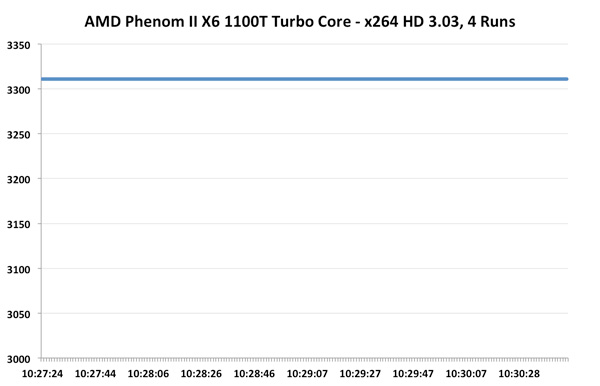
Unfortunately we see nothing of the sort. Turbo Core is pretty much non-functional on the Phenom II X6, at least running this workload. Average clock speed is a meager 3.31GHz, just barely above stock and likely only due to ASUS being aggressive with its clocking.
Now let's look at the FX-8150 with Turbo Core. The base clock here is 3.6GHz, max turbo is 4.2GHz and the intermediate turbo is 3.9GHz:
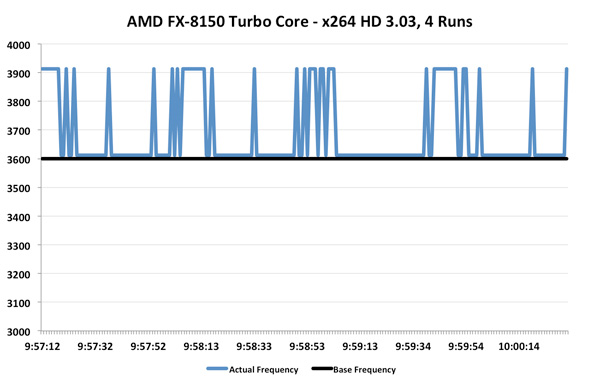
Ah that's more like it. While the average is only 3.69GHz (+2.5% over stock), we're actually seeing some movement here. This workload in particular is hard on any processor as you'll see from Intel's 2500K below:
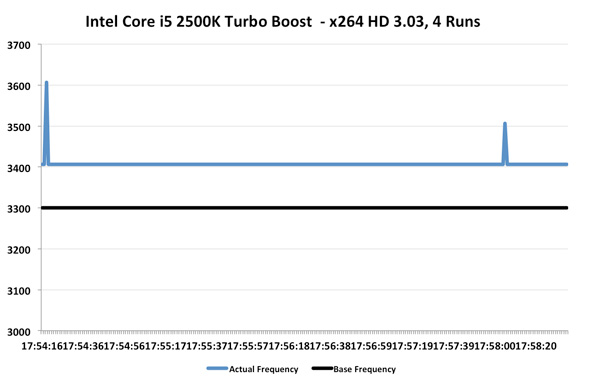
The 2500K runs at 3.3GHz by default, but thanks to turbo it averages 3.41GHz for the duration of this test. We even see a couple of jumps to 3.5 and 3.6GHz. Intel's turbo is a bit more consistent than AMD's, but average clock increase is quite similar at 3%.
Now let's look at the best case scenario for turbo: a heavy single threaded application. A single demanding application, even for a brief period of time, is really where these turbo modes can truly shine. Turbo helps launch applications quicker, make windows appear faster and make an easy time of churning through bursty workloads.
We turn to our usual favorite Cinebench 11.5, as it has an excellent single-threaded benchmark built in. Once again we start with the Phenom II X6 1100T:
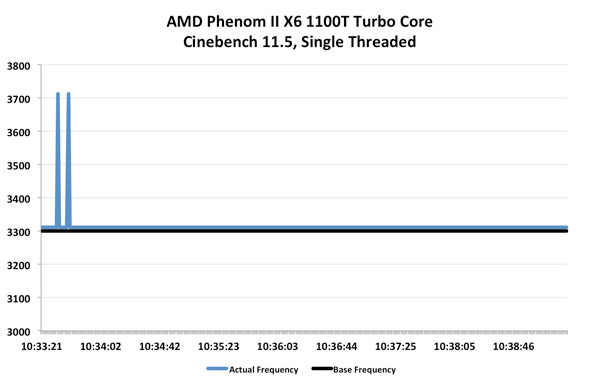
Turbo Core actually works on the Phenom II X6, albeit for a very short duration. We see a couple of blips up to 3.7GHz but the rest of the time the chip remains at 3.3GHz. Average clock speed is once again, 3.31GHz.
Bulldozer does far better:

Here we see blips up to 4.2GHz and pretty consistent performance at 3.9GHz, exactly what you'd expect. Average clock speed is 3.93GHz, a full 9% above the 3.6GHz base clock of the FX-8150.

Intel's turbo fluctuates much more frequently here, moving between 3.4GHz and 3.6GHz as it runs into TDP limits. The average clock speed remains at 3.5GHz, or a 6% increase over the base. For the first time ever, AMD actually does a better job at scaling frequency via turbo than Intel. While I would like to see more granular turbo options, it's clear that Turbo Core is a real feature in Bulldozer and not the half-hearted attempt we got with Phenom II X6. I measured the performance gains due to Turbo Core across a number of our benchmarks:

Average performance increased by just under 5% across our tests. It's nothing earth shattering, but it's a start. Don't forget how unassuming the first implementations of Turbo Boost were on Intel architectures. I do hope with future generations we may see even more significant gains from Turbo Core on Bulldozer derivatives.
Independent Clock Frequencies
When AMD introduced the original Phenom processor it promised more energy efficient execution by being able to clock each core independently. You could have a heavy workload running on Core 0 at 2.6GHz, while Core 3 ran a lighter thread at 1.6GHz. In practice, we felt Phenom's asynchronous clocking was a burden as the CPU/OS scheduler combination would sometimes take too long to ramp up a core to a higher frequency when needed. The result, at least back then, was that you'd get significantly lower performance in these workloads that shuffled threads from one core to the next. The problem was so bad that AMD abandoned asynchronous clocking altogether in Phenom II.
The feature is back in Bulldozer, and this time AMD believes it will be problem free. The first major change is with Windows 7, core parking should keep some threads from haphazardly dancing around all available cores. The second change is that Bulldozer can ramp frequencies up and down much quicker than the original Phenom ever could. Chalk that up to a side benefit of Turbo Core being a major part of the architecture this time around.
Asynchronous clocking in Bulldozer hasn't proven to be a burden in any of our tests thus far, however I'm reluctant to embrace it as an advantage just yet. At least not until we've had some more experience with the feature under our belts.


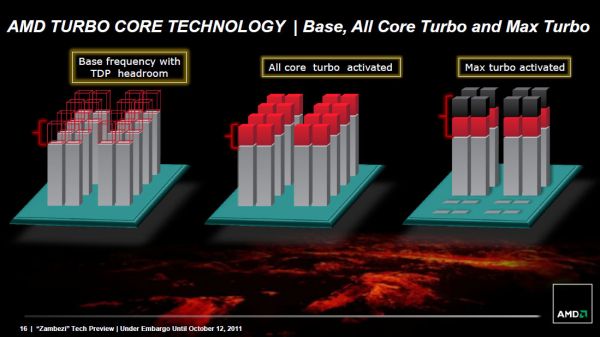








430 Comments
View All Comments
TiGr1982 - Monday, October 17, 2011 - link
Indeed, much much better performance was expected from BD. I was an AMD focused PC buyer since 2005, at AMD "golden age", when I purchased AMD Turion-based laptop. That CPU was actually better than the corresponding Intel competitor at the moment - Pentium M Dothan, as probaly some people remember.We know the rest of the story since then till now...
But the released BD-based product in its current state seems to be barely concurrent at all on the desktop market. Presumably, its popularity will be much lower, than in case of previous Phenom II lineup...
TiGr1982 - Monday, October 17, 2011 - link
By "concurrent", I actually meant "competitive".psiboy - Tuesday, October 18, 2011 - link
Why are there no benchmarks with it overclocked... especially gaming? Would be relevant as these processors are shipping unlocked as standard.. all I'm asking for is a reasonable overclock on air to be included...eldemoledor25 - Tuesday, October 18, 2011 - link
I think they rushed all wanting to position their review as the first, if you read the other post of the network goes bullozer better positioned than the i7 2600K in many things over which a pricipio dicen.el problem was in the bios the asus and gigabyte motherboards, released immature bios fact overclock would hold more, as you may ASRock and MSI makes a bulldozer to 4.6 ghz be better than the i7 and i5 5.2GHz oc do not believe me check this and read well.1.-http: / / www.madboxpc.com/foro/topic/161318-la-verdad-sobre-el-amd-fxo-bulldozer/page__st__20
Greetings to all!!!
Martin281 - Wednesday, October 19, 2011 - link
Well, the situation among AMDs CPU is still the same...good ideas, great expectitions and manufacturing delays resulting in inappropriate results compared to Intel. Bulldozer would have been a way competitive 2 years ago, not these days. At this point AMD desperately needs way higher clock speeds and core optimizations to be competitive..the predicted 10-15% performance per watt increasing each year is really funny when compared to planned intel´s cpu roadmap (just known information that 1Q/2012 to-be-introduce ivy bridge´s TDP in top performance class is to drop from 95W to 77W, that is almost 20% only in power consumption - not to mention performance boost caused also by 22nm manufacturing process). I am worried, that the performance gap between intel and AMD cpus is going to broaden in the near future without "any light in the darkness bringing the true competition in the CPU field".siniranji - Wednesday, October 19, 2011 - link
waiting for the BD to come, but now, what a disappointment, but AMD should continue to compete with intel, otherwise, there wont be any battle to watch. I love to see a good pricing from AMD.loa567 - Wednesday, October 19, 2011 - link
I think you are wrong on one point, about the FPU. You claim that one bulldozer module has the same FP capacity as earlier AMD processors. However, in reality it has twice the (theoretical) capacity Whereas each K8/K10 core had one 128-bit FP unit, each bulldozer module has 2 x 128 bit FP units. They can work together as one 256-bit, when used with the new instructions (AVX and others). See for example this page for details: http://blogs.amd.com/work/2010/10/25/the-new-flex-...However, it is strange that this does not show in performance. Could anyone explain this to me?
Pipperox - Thursday, October 20, 2011 - link
It does show on performance.In SiSoft Sandra, 4 Bulldozer modules easily beat 6 Thuban cores.
Same goes for floating point intensive rendering tasks such as Cinebench and 3dsMax.
beck2050 - Friday, October 21, 2011 - link
"in single threaded apps a good 40-50% advantage the i5 2500K enjoys over the FX-8150."These are the apps most people use, duh.
core for core Bulldozer is epic fail. This is not going to be a popular desktop chip at all. As for servers, AMD's share has dropped from 20% to 5,5% in the last few years. I doubt this chip will be the savior.
richaron - Friday, October 21, 2011 - link
They have lost ground in the server market, so a radical new design wont make a difference...? I admire your logic.For the record I specifically look for programs/games which are multithreading, it often shows good programming on the whole. Unless of course there are other factors limiting the system (like net speed, or gpu). Perhaps I'm just ahead of the curve compared to you're average troll, duh.